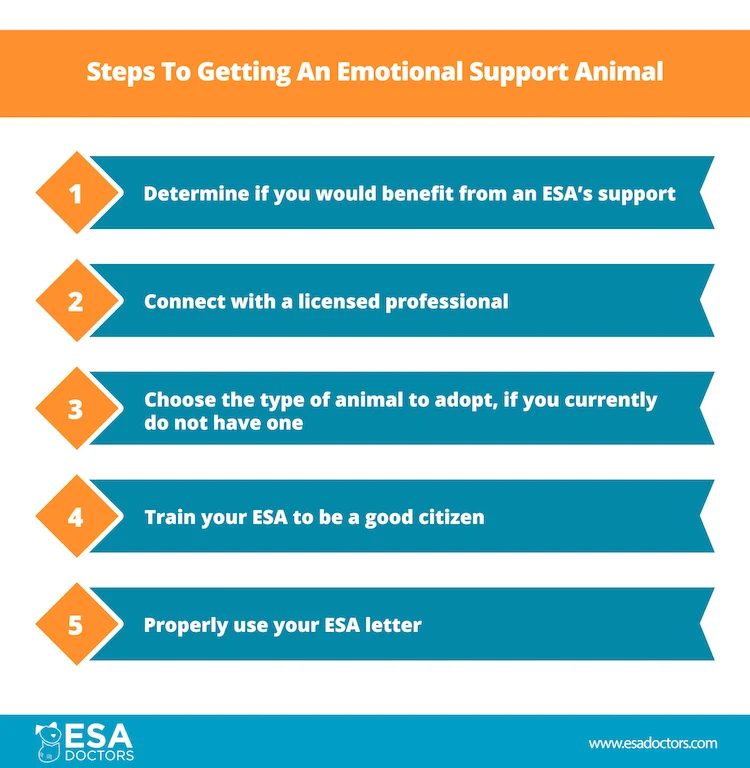There’s a very good chance you can turn your existing pet into an emotional support animal if you get an ESA letter. If you don’t have a pet right now, you can adopt a dog, cat, bird, rabbit, fish, turtle, rodent, or other small household animal to be your ESA.
As soon as you complete the steps for your pet to become an emotional support animal, ESA laws give you the legal right to live in no-pet residential buildings without having to pay any extra fees or deposits. Read on, and we’ll tell you exactly how to do it!
The 5 Steps to Get an Emotional Support Animal
- Reflect on your mental health and relationship with animals
- Talk to a mental health professional
- Choose the type of animal to adopt if you currently don’t have a pet
- Train your ESA to be a good citizen
- Share your ESA letter with your landlord
If you believe you would benefit from an emotional support animal, complete the ESA Questionnaire using the link below to see if you qualify for a legitimate ESA letter.
1. Reflect on your mental health and relationship with animals
The first step in getting an emotional support animal is to self-evaluate your feelings and whether a pet could improve your situation. If you’ve been depressed, anxious, or not the best version of yourself you know you can be, an ESA can really help you.
Emotional support animals help with common conditions like depression and anxiety, as long as it’s chronic and has a major effect on your life.
These are some of the conditions that qualify:
- Learning Disabilities
- Attention Deficit Disorder (ADD)
- Anxiety Disorders
- Depression
- PTSD
- Phobias
If you think you have one of these conditions and you know that being around pets makes you feel better, the next step is to talk to a mental health professional.
2. Talk to a mental health professional
If you think an emotional support animal could positively affect your life, the next step is to contact a mental health professional because you’ll need them to give you an ESA letter for your pet to legally become your ESA. You can ask your psychiatrist, psychologist, physician, social worker, LMFT, or nurse to write you one.
If your healthcare provider won’t write an ESA letter, maybe because they don’t know how or they’re not qualified, we can help. We’ll connect you directly to a licensed healthcare professional who will take care of your ESA letter while treating you with compassion and kindness.
3. Choose the type of animal to adopt if you currently don’t have a pet
Already have a pet? Great news: they can become your ESA once you get your ESA letter. Looking to adopt? Your local animal shelter or rescue can help you find the perfect new best friend. Most well-behaved pets that can safely live in your home can qualify as ESAs.
The key is finding a pet whose personality matches your lifestyle. For instance, if you live in a small apartment, work long hours, and need help managing anxiety, a high-energy breed like a Siberian Husky (who needs tons of exercise, space, and attention) might add more stress than support. Instead, consider a laid-back companion — maybe a cat or a more relaxed dog breed like an English Bulldog who’s happy to be your cozy apartment buddy.
A variety of animals can serve as an emotional support animal, including:
4. Train your ESA to be a good citizen
Let’s clear up a common misconception: ESAs don’t need specialized disability training like service dogs do. Service dogs are trained for specific tasks — like guiding someone who is blind or alerting someone to an oncoming seizure. Your ESA, on the other hand, provides comfort and support simply by being your companion.
But here’s the important part: while your ESA doesn’t need disability-specific training, they absolutely need basic obedience training. Why? Because a well-behaved ESA:
- Makes a better emotional support companion
- Is more welcome in housing environments
- Helps you avoid potential issues with landlords
- Prevents property damage you’d be responsible for
Think of it this way: your ESA’s good behavior helps protect your housing rights. Even though you’re exempt from pet fees and deposits, landlords can still deny ESA requests if the animal poses a risk to others or property. Basic training ensures your ESA can be the supportive companion you need while being a good neighbor, too.
5. Share your ESA letter with your landlord
Got your ESA letter? The next step is to let your landlord know. You’ll need to submit the letter and request an exception to any no-pet policies so your emotional support animal can live with you.
Your landlord has 10 days to review your request. They can only deny it in rare cases — for example, if there’s proof your ESA has harmed others or caused major property damage.
Once approved, your ESA can live with you regardless of any no-pet rules in your building, HOA, or co-op. Your landlord can’t:
- Restrict breeds or weight
- Charge pet fees or deposits
- Keep existing pet deposits (if your pet later qualified as an ESA, you can request a refund)
Feeling unsure about approaching your landlord? Check out our guide on how to tell your landlord.
See if You Qualify for an Emotional Support Animal
Get the Love and Support you deserve!
If you have a loved one interested in getting an emotional support animal, share the simple steps below with them.











I admire how this blog promotes kindness and compassion towards ourselves and others We could all use a little more of that in our lives
I am so grateful for the community that this blog has created It’s a place where I feel encouraged and supported
Thank you for creating such valuable content. Your hard work and dedication are appreciated by so many.
Thank you for your feedback and kind words! We really appreciate it!
I am a college student 16 hours from home suffering from a variety of symptoms. I have never been to a therapist or discussed my feelings because I never felt comfortable seeking help. These symptoms are slowly overtaking my daily life and I feel an ESA would provide me the comfort and support I need. What are my first steps? My college has quite a few requirements that the letter from a professional must include. I feel so lost. I have no connections here.
Sorry to hear about the difficult time you’re going through. The transition to college can be really tough mentally and emotionally for many students. We help many students get accommodation for an emotional support animal. The first step would be to fill out our online questionnaire here: https://app.esadoctors.com/checkout/
After that, you will be connected with a licensed healthcare professional. They can see if you qualify for an ESA letter and work with you on your school’s specific requirements.
I suffer from seizures, Bipolar 2, severe anxiety, PTSD and it does not take much for me to get overwhelmed and get extremely stressed. With and ESA dog are you allowed to tak them to work with you?
Emotional support animals can do wonders for people with conditions like yours. Many consider them life-saving. It would be an incredible benefit for many people if they could bring their ESAs to work. Unfortunately ESAs do not have workplace rights, they are only allowed in residential buildings. Some employers however will accommodate ESAs and pets as a courtesy. We suggest speaking with your HR department to see what their policies are.
I have a psychiatrist and I have a therapist I suffer from a PTSD bipolar depression severe anxiety and panic attacks I would like to find out how to get an ESA
The best place to start would be by having a discussion with your psychiatrist or therapist. You can qualify for an emotional support animal by getting an ESA letter from a licensed healthcare professional. A psychiatrist is certainly qualified to write an ESA letter. If you’re unsure about how to ask or what to say, we wrote a guide which you might find useful: https://esadoctors.com/ask-doctor-emotional-support-animal-letter/
Can you only have one esa in apartment housing? I have a letter from a psychologist and 1 esa a rescue pug but think I would benefit from a second dog. Is that allowed?
You can absolutely have more than one ESA. It is actually quite common. If you have multiple emotional support animals, you’ll need to make sure your ESA letter covers each one. Many owners find that one ESA helps with one aspect of their health issue while another helps more with another aspect. You can read more about having more than one ESA at this link: https://esadoctors.com/how-many-emotional-support-animals-can-you-have/
I suffer from severe depression to the point where I have contemplated suicide. I also have epilepsy but thankfully haven’t had a seizure in over a year. None of my family really has any thing to do with me, and that makes it even harder for me to deal with. I know an ESA would do me some good but I don’t have a car to get to any of the places to get started.
We’re so sorry to hear about the problems you’re dealing with. We can connect you to an LMHP that specializes in ESA recommendations. The LMHPS we work with offer their services remotely so you don’t need to leave your home. You can get started at this link: https://esadoctors.com/esa-questionnaire/
My PCP has given me an ESA letter, however my landlord says if it’s not a service dog for disability I still have to pay deposit.
Your landlord is incorrect, under Fair Housing rules landlords cannot charge fees or deposits for an emotional support animal. Both service dogs and emotional support animals are protected. If you were forced to pay a pet fee or deposit for a valid emotional support animal, you may be entitled to a refund: https://esadoctors.com/esa-fees-refunded/
I suffer from severe anxiety and panic attacks. I’ve tried everything and nothing works. Would like to try ESA
We strongly recommend speaking to your therapist or doctor about the issues you’re facing. Emotional support animals can be a great way to help with anxiety and panic attacks, but it’s important to also seek regular support from a mental health professional. If your current providers can’t help with an ESA letter, we can help connect you one. You can get started by clicking here: https://esadoctors.com/esa-questionnaire/